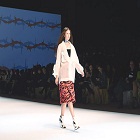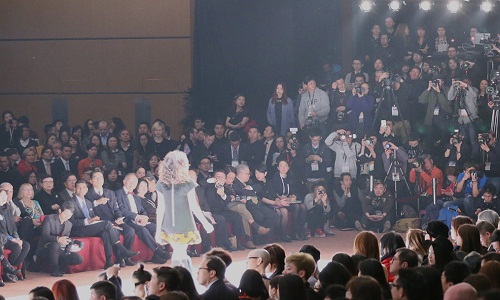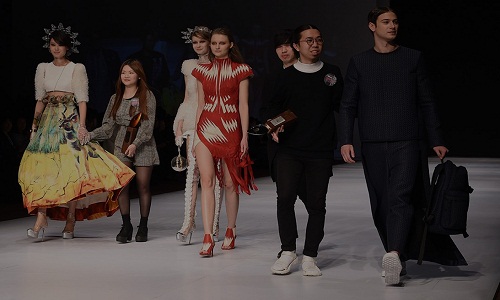FW
Indore, Madhya Pradesh, is a hub for readymade children’s wear. There are over 3,000 garment manufacturing units and the industry is worth about Rs 1,500 to Rs 1,800 crores. Sales of readymade garments are expected to rise by over 20 per cent this festive season due to a rise in demand from neighboring states and a strong local market.
Anticipation of better crop production due to good rains in the country is expected to enhance the spending capacity of consumers. Local manufacturers are expecting retail counters to witness a big jump in sales from October due to festivals such as Navratri and Diwali. Sales of garments have picked up since Raksha Bandhan and are expected to remain firm until the end of the year due to the series of festivals and weddings. This season orders for women’s wear and men’s wear have also come in from Karnataka, Tamil Nadu, Rajasthan, Gujarat and Maharashtra.
Garment demand is expected to slip a bit during mid-September but is again expected to pick up from October. Indore is the largest city and the commercial center of Madhya Pradesh. Manufacturing of readymade garments is done by very small manufacturers mostly at home.
As weak rains limit yield recovery, cotton production in India will recover slower than thought earlier, say US officials. Yields will grow after a decent monsoon across many areas, but by barely by enough to outweigh the sharp drop in sowings. ‘Despite a generally good monsoon, below normal rains in some cotton-specific growing areas is expected to lead to yields that are lower than the USDA official forecast,’ the Delhi bureau of the Department of Agriculture (USDA) warned. The bureau based in New Delhi saw the country's cotton crop at 26.50 million bales, barely higher than the six-year lows touched last season.
The USDA had forecast that the crop would recover to 27 million bales this year from 26.40 million bales in 2015-16. Cotton plantings in India are forecast to fall to a seven-year low of 11.00 million hectares, down from 11.90 million hectares in 2015-16. ‘Higher input costs and better price realization for competing crops has prompted farmers to move away from cotton and pushed acreage downward from a year ago,’ the bureau informed.
The decline is not universal, as lower plantings in Gujarat and Telagana outweigh higher plantings in Madhya Pradesh and Maharashtra. ‘The area in the state of Telangana has fallen as farmers have opted to plant more area in pulses, maize and paddy,’ the bureau said. Last week the International Cotton Advisory Committee forecast Indian cotton sowings at 11.2 million hectares noting that ‘better prices for competing crops, the late arrival of the monsoon and yield losses from pest pressure last season discouraged farmers’.
The Delhi bureau forecast consumption and imports in line with the official USDA forecasts at 24.0 million bales and 1.0 million bales respectively.
Fair Wear Foundation has published a report ‘Fair Wear Foundation (FWF) India Country Study 2016’. The 56 page report states there is no child labour in the garment industry of the country now as compared to what was in 2000. Similarly there is no discrimination either on the basis of religion or caste. And to top it all, women get equal pay for equal work as men do and get.
The report says that during the FWF audits, evidence of forced and/or bonded labour was difficult to find and is mostly linked to forced overtime though the report also says that there is violation in the area of occupational health and safety. The FWF audit was conducted in apparel manufacturing hubs like Delhi, Noida, Tirupur and Karnataka between 2013 and 2016.
In the North, it was observed that the second most recurrent violation is the lack of internal and formal means of communication followed by the absence of legal contracts. In the South, the second highest number of violation is in the area of payment of wages followed by the lack of internal and formal means of communication. ‘Most workers are actually hired through recommendations of fellow workers or contractors, who help recruit workers from their native villages,’ it further adds.
The report stresses on increasing the activities of labour department as it figured out that the Department of Labour in Noida only has 12 labour inspectors who, in 2015-2016, carried out 21 inspections at 964 garment factories in the region. FWF has been active in India from past 13 years and its 40 members (mostly those in fashion and sportswear) source from more than 160 Indian factories. Of these factories, 45 per cent are located in North India while 55 per cent are based in South India.
Avanprint will be held in the US in September 2017. This is a digital printing technology event. The sourcing platform will feature exhibits from emerging digital textile printing technology developments, including inks, machinery, software and products. This is a new event organized by Messe Frankfurt.
Avanprint USA will act as a networking hub for sourcing professionals, fashion textile buyers and market leaders in the digital printing industry to discuss how these new innovations will benefit their businesses and production processes. A textile print trend area will also be on display at the trade show. The event will serve the needs of the North American apparel and textile industries. It will bring together digital printing, apparel design and sourcing mavens and provide an innovative business platform where forward-thinking exhibitors and visitors can connect directly with technology leaders.
The US has become an exciting, expanding market for digital textile printing. Avanprint USA will provide industry affiliates the opportunity to showcase their collaborative advancement in digital printing technology. For the first six months of 2016, US digital textile production capacity increased 30 per cent. The US digital textile market produces 51 million square meters of fabric each year, making it one of the top global manufacturing divisions.
Chinese textile company Zhejiang Daoqin will invest Rs 600 crores in a textile plant in Uttarakhand. This is likely to help the state’s textile industry take major steps towards growth. This venture will also provide employment to around 8,000 people. Uttarakhand is a suitable business destination for industrialists due to benefits like rebate in per unit electricity bill, exemption from electricity tax, and a 50 per cent rebate in land for setting up a textile industry. The state is expecting more Chinese firms to make investments.
Surplus ground water and proximity to neighboring countries like Nepal and China have attracted industrialists to the textile park. Another advantage is its border with Uttar Pradesh and good transportation facility to other parts of the country.
Zhejiang Daoqin will be the first Chinese company to make 100 per cent foreign direct investment in India. Uttarakhand has launched a mega textile policy under which new projects having an investment above Rs 75 crores will be christened as a mega textile park project. Companies setting up a new unit will be given a 50 per cent rebate on the land price.
The allottee has to pay 20 per cent of the land premium at the time of allotment and the balance payment is to be deposited within seven years in equal installments at the prevailing rate of interest.
The Bangladesh Garment Manufacturers and Exporters Association (BGMEA) has urged 553 garment factories to hurry up in remediation work to avoid the risk of termination of business relations with international buyers. These factories were warned of discontinuing of business relations by Accord, the European brands and buyers’ platform conducting activities, for ensuring workplace safety in the garments industries in Bangladesh for their failure of co-operating with its remediation programs and also for slow progress in remediation works and those factories are faced Stage 1 and 2 notifications by the Accord on Fire and Building Safety in Bangladesh.
BGMEA has already started sending letters to default factories and urged them to speed up remediation process to avoid business termination with the European buyers. It may be recalled that Accord had earlier warned 553 readymade garment factories of termination of business relations for their failure to make expected progress in remediation of their factory buildings. The European buyer’s body had also issued ‘non-compliance notifications’ (called stage-1 of escalation protocol) to 449 RMG factories due to inadequate cooperation in finalising Corrective Action Plans, executing remediation and refusal to meet the requirements of the platform. According to the terms of conditions of Accord, this is the primary warning for business termination, sources said.
Accord has so far cut business relations with 37 suppliers due to their failure in making required progress in remediation. Over 1,600 factories have so far been inspected as the European buyers want to make safe factories from where they procure products. Alliance the platform for North American apparel buyers that has so far inspected around 700 factories. And after inspection, it has terminated business relations with a total of 96 local garment factories for their failure to cope with the compliance issues.
Apparel Training and Design Centre (ATDC), India’s largest quality vocational training provider for the apparel sector recently conducted an 'Interactive Session for Apparel Manufacturing Organizations, Entrepreneurs (Boutiques) & Apparel & Fashion Institutes at its Chandigarh center. This session was conducted by ATDC Training of Trainers (TOT) Academy to showcase the wide range of workshops and trainings that have been conducted earlier to benefit the Apparel Industry Pan India.
The purpose was to understand the requirements in this area so that workshops and trainings may be customized to benefit the region of Chandigarh, Punjab and Himachal Pradesh. RMG makers, industry professionals and fashion Institutes such as Gini & Jony, Eveline International Ludhiana, Active Clothing, Raymond Store, Northern India Institute of Fashion Technology (Mohali), Inter National Institute of Fashion Designing, Home Science College etc, participated in the interactive session.
Speaking on the occasion, Roopali Shukla Advisor, ATDC-TOT Academies & regional ATDCs said that conducting such workshops helped them to understand the needs and the hurdles faced by the Apparel sector. Her company was able to create professionals who will accelerate the growth of the Apparel sector through such training by experienced trainers.
The session focused on discussing topics such as defining roles and responsibility, optimal utilization of human and capital resources, improving quality and its implementation techniques. This would enhance productivity and efficiency and develop lean teams and lean manufacturing which would benefit the Apparel Industry.
ATDC TOT Academy is an institution that operates as a resource centre which sets benchmarks and overall quality parameters for those in the business of skilling in the apparel sector. The key objective of the Academy is to bring about an overall systematic change in the Apparel Industry while providing better quality trainers for industry.
Global fashion brands and retailers have discontinued their business relations with six more RMG factories in Bangladesh for their failure to implement workplace safety measures as per the standards set by two separate platforms of the buyers, Alliance and Accord. With the six, the total number of RMG factories with which the Accord on Fire and Building Safety and the Alliance for Bangladesh Workers Safety have severed business relations on different occasions on the ground of workplace safety, reached 136. Of them, Accord has cut business ties with 41 supplier factories while the Alliance with 95 factories.
The latest is that between September 1-8, Accord terminated business relations with four of its suppliers as the factories failed to make required progress in remediation while Alliance cut business ties with two of its suppliers due to closure of the units.
While the factories which faced Accord termination are Han A Hats & Caps and Hanwen BD and Danys Knitwear and Kento Asia in Gazipur. The factories which were suspended from the Alliance list are Asian Apparels and Campha Outdoor based in Chittagong. Meanwhile, the North American retailers’ group has announced that five more Alliance-affiliated factories completed remediation during the months of August and September. That totals the number of fully-remediated factories to 39.
"The CENTRSTAGE fashion event in Hong Kong saw young fashion designers compete at the Young Fashion Designers’ (YFD) contest and Kenneth Cheung emerged the winner. He received a cash prize and a one-month internship program at the international fashion brand ‘Facetasm’ Japan. The other winners of the 40th Hong Kong Young Fashion Designers’ contest are: Kenneth ‘No Country for Old Man’ first runner-up, Lee Tak-shing ‘Addendum’ second runner-up and the best footwear & accessories design award was taken up by Gim Wong."

The CENTRSTAGE fashion event in Hong Kong saw young fashion designers compete at the Young Fashion Designers’ (YFD) contest and Kenneth Cheung emerged the winner. He received a cash prize and a one-month internship program at the international fashion brand ‘Facetasm’ Japan. The other winners of the 40th Hong Kong Young Fashion Designers’ contest are: Kenneth ‘No Country for Old Man’ first runner-up, Lee Tak-shing ‘Addendum’ second runner-up and the best footwear & accessories design award was taken up by Gim Wong. Backpacker Kenneth Cheung, was declared the overall champion of YDC.

Asked about the essence of his design, Cheung said he had intentionally incorporated military elements into his design by adding electric red embroidery. This created a contrast to the muted palette of green, dark blue and brown hues, leaving a strong impression on the judging panel.
Gim Wong, awarded the second runner-up and the best Footwear & Accessories Design Award was participating in a fashion competition for the second time. Displaying strong enthusiasm for fashion design, Wong aspires to pursue her career in the industry. By her win, she, in a way, encouraged young fashion talent to join the YDC which is one of the most prominent competitions in the industry to gain more hands-on experience.
Hiromichi Ochiai, Designer for Japanese fashion label Facetasm was the VIP judge at the competition this year. He earned the distinction of becoming the first Japanese designer to reach an LVMH prize final. At the 13th Mainichi Fashion Grand Prix in 2013, Ochiai received the Shiseido Award for best new designer of the year. Last year, he presented his 2016 spring/summer collection at Georgio Armani’s Armani / Teatro at the Milan Fashion week. Other senior industry and media representatives joining the judging panel were : Lawrence Leung, Chairman of HKTDC Garment Advisory Committee who was the chief judge; Federico Tan, Director, social/capital, Bonnie Lam, VP, Yoho! Media Division, Reeds Yau, Director, Creative & Visual Merchandising, ImagineX Group, Jonathan Lee, Senior Buyer, Shine Trading (HK) Ltd; and Virginia Chan, Head of Footwear, i.t Apparels Ltd. They selected the best works based on creativity and originality, market potential, workmanship, use of fabrics and overall visual appeal.
"Leading trend forecasting companies Fashion Snoops and WGSN hosted seminars at the CENTRSTAGE fashion event in Hong Kong. The discussions centered around trends for the Asia-Pacific fashion market. While Fashion Snoops led ‘The Key Summary of Retail Trends for 2017’ seminar on September 7, WGSN led the ‘Retail Destinations of the Future’ seminar on September 8. The seminars were part of the CENTRESTAGE fashion event held from September 7-10, organised by the Hong Kong Trade Development Council (HKTDC)."

Leading trend forecasting companies Fashion Snoops and WGSN hosted seminars at the CENTRSTAGE fashion event in Hong Kong. The discussions centered around trends for the Asia-Pacific fashion market. While Fashion Snoops led ‘The Key Summary of Retail Trends for 2017’ seminar on September 7, WGSN led the ‘Retail Destinations of the Future’ seminar on September 8. The seminars were part of the CENTRESTAGE fashion event held from September 7-10, organised by the Hong Kong Trade Development Council (HKTDC).
Trendspotting for Asia-Pacific fashion

For Fashion Snoops, Michael Leow, Asia-Pacific Sales & Marketing Head, presented an analysis of key trends impacting fashion retail for the upcoming year. Leow said ahead of each season, his company works to map and analyses cultural shifts and new ideas that will impact consumer demand and fashion decisions. Talking about mapping macro-trends, Leow said there are 10 macro-trend stories that will impact fashion over the next year. He presented five of these key macro-trend stories.
First trend was ‘Nowstalgia’, defined as the trend story of looking at the past through the lens of today. Consumers are showing a tendency to seek out brands that embrace their glory days with the convenience of today’s technology. He said this trend will also showcase the blurring of digital and analogue elements citing the example of classical jewellery designs incorporating emoji imagery.
‘Beaux Arts’ the second trend is the rise of the artist as an intellectual in response to several seasons of athletic wear. Leow said people are on the lookout for a more intellectual and bookish feel. This trend story will be particularly impactful during the Autumn/Winter 2017-2018 season and feature an eclectic mix of 70’s inspired colours, such as burnt orange, patterns such as the classic chevron, and textiles including denim.
The third trend, is the awakening of the global spirit as people are seeking out new and meaningful travel experiences. For Spring/Summer 2017, this trend story will feature the micro-trend of ‘Raw Coast’ which is a surf aesthetic that features minimalistic but rustic designs. For Autumn/Winter 2017-18, this trend story will feature the micro-trend of ‘Indo’ exemplified by Vietnamese nature and culture. Leow said that this trend will feature colours inspired by the Vietnamese jungle incorporated into local cultural and military designs.
The fourth is ‘New Luxury’ that represents modern desire for genuine quality and natural materials which he said was a luxury aspiration accessible to all. For Fall/Winter 2017-18, he detailed the micro-trend of “Iliad”, an ancient Greek inspired trend story. In terms of colour, this micro-trend will feature a sumptuous range of neoclassical hues such as garnets and milky marbles.
And finally it’s ‘Action’ that represents the cultural shift of masses rebelling against the upper echelons of society while impacted design work will be the crystalizing of discontent. For Autumn/Winter 2017-18, this trend story will be seen in the micro-trend of ‘Re: Volution’ that features military aspects in an urban setting. He explained that designs will have hip-hop attitudes mixed with brash, punk sensibilities and feature materials such as scorched denim, rugged canvas and mesh.
Focus on Millennial consumer
For WGSN Erica Ng, Senior Editor Retail Intelligence Specialising in the Asia Pacific region explored changing consumer expectations and behaviour of the millennial generation that is fuelling the creation of new retail destinations. Understanding shifting gears of the millennial consumers for the upcoming trends impacting fashion designs, Erica examined how the evolution of consumers is fuelling the upcoming trends that will impact retail destinations of the future. Focusing on the millennial consumer generation, Erica explained that this generation is maturing and reaching their peak purchasing years and should be a key target market for retailers. She explained how millennials have an increasingly ambiguous relationship with ownership and prefer experiences over simply purchasing and owning things.
With 68 per cent of consumers now willing to rent their personal belongings for profit, she defined millennials as generation rent. In terms of fashion retail, she said that this generation treats clothes as assets rather than personal goods with sentimental value and that retailers need to cater to this lifestyle in new ways. With this in mind, Erica suggested that trend-forward retailers can capture market share by offering subscription-style services and curated selections to cater to this group that is often inundated with too many options and too little time.
On of retail synergies holding the key with regards to this new style of consumer, the lady discussed how the millennial lifestyle would disrupt traditional retail and shared her insights on upcoming retail destination trends. She explained that successful retailers will need to find synergies between mobile apps, online shopping, physical retail and social media to effectively capture and maintain market share with this generation.
Focusing on digital retail innovations, she identified third party retail platforms and conversational commerce as key retail destinations of the future. She further explained that third party retailing removes the brand away from centre of the retail experience but has the potential to create value for both retailers and consumers. Third party retailing platforms can draw customers by offering the convenience of curating and selling multiple brands on a single platform.
She said these new platforms are also particularly effective when combined with conversational commerce to leverage endorsements from social influencers such as celebrities. She also added that established brands can partner with these new types of platforms in order to expose themselves to new customers even if it means they have to relinquish control of the retail experience.












